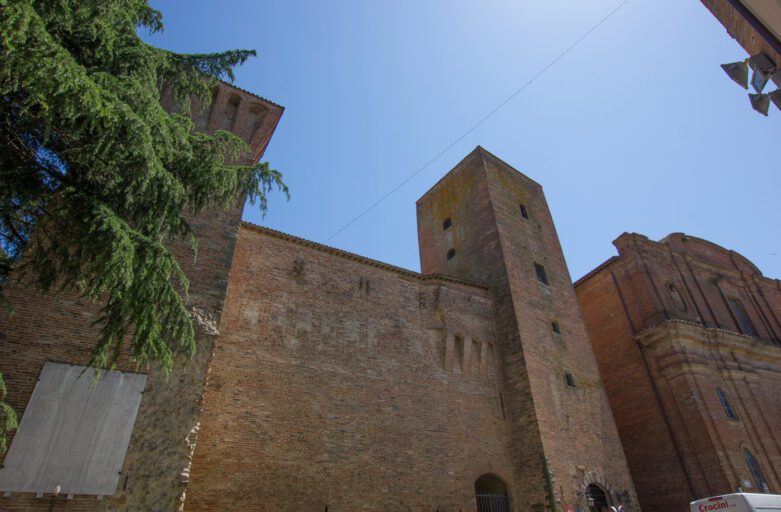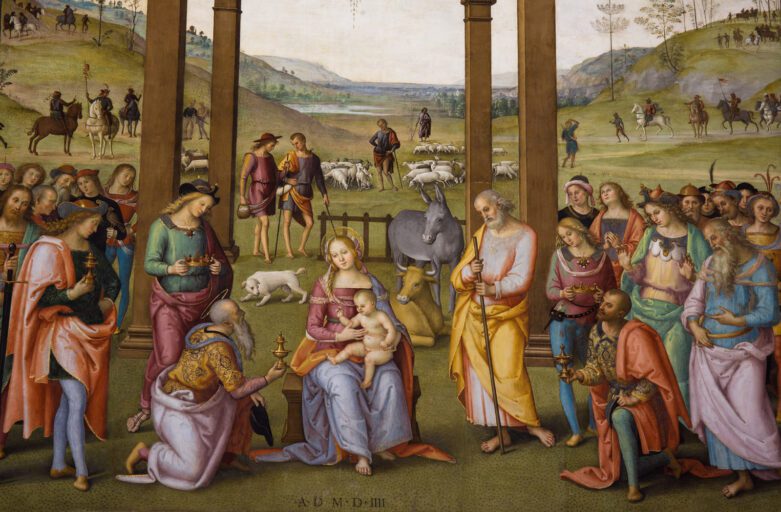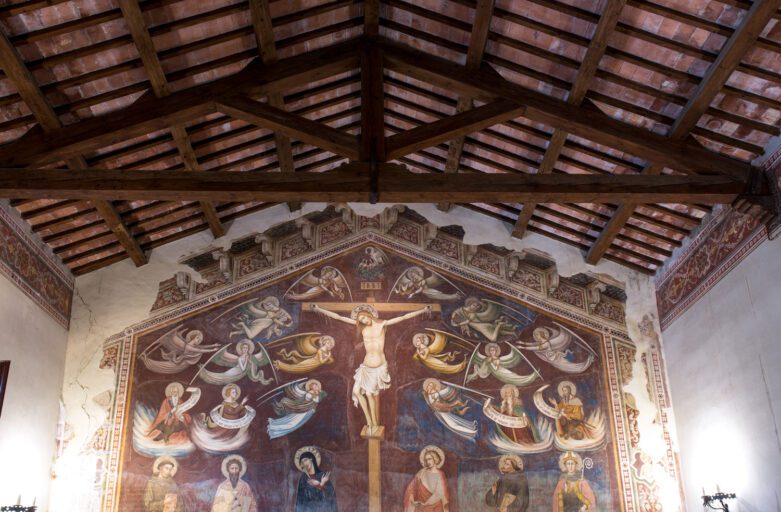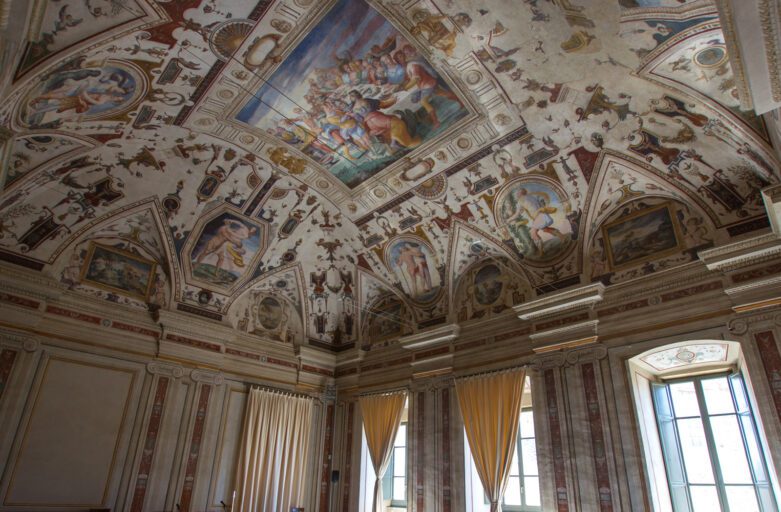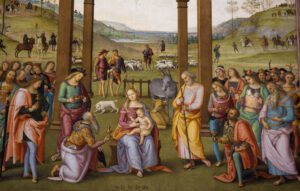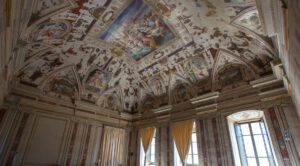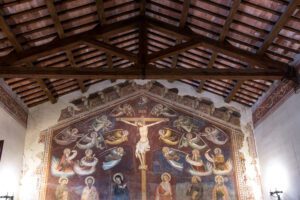The Rocca dei Perugini Nowadays
The powerful Rocca dei Perugini, “Fortress of Perugian (soldiers),” was built along the town walls near Porta Perugina, the town gate toward Perugia, in fact. This is whence, already in 1296, the road called Via Pievaiola started, that still nowadays connects Città della Pieve and Perugia.
The fortress, currently incorporated in the town center, faces Matteotti Square; and thanks to an intelligent restoration, has become a key factor for the development of tourism.
With reference to its structure, the stronghold is a noteworthy example of military architecture in Umbria. At the same time, its very presence makes an important chapter in the history book of the town, insofar as it reminds us of the time when it was controlled by Perugia. The village was then called Castel (castle) della Pieve; pieve meaning a country church.
The Fortress, Base of Perugia's Power
Perugia had been controlling this area since the 12th century, for basically two reasons: to defend the territory of Umbria against Siena (Tuscany), a powerful pro-Emperor town; and to have an outpost toward the land called Chiugi, that is the area between the Lake of Chiusi and Lake Trasimeno<. Anyway, since Città della Pieve too was a definitely Ghibelline (pro-Emperor) town, and was protected by Frederick II of Swabia, it became a free Commune – free from Perugia, that is. Precisely in that period, the 13th century, the town took on the form it would preserve till nowadays. By looking at it from above, one will notice that its borders draw the outline of an eagle: a clear symbol of the Emperor who threateningly marched toward Rome.
Città della Pieve was reconquered by Perugia (Guelph, i.e. anti-Emperor) in 1250, the same year in which Frederick II died. This notwithstanding, the citizens would continually rebel in the name of Communal freedom. Therefore, in order to prevent revolts, in 1326 Perugia decided to build a fortress that may both monitor the agitated town and make its own garrison safer. Ambrogio and Lorenzo Maitani were entrusted with the project. The latter was dubbed universalis caput magister, i.e. the “universal foreman” (literally, “head-master”; capomastro in Italian). He also distinguished himself in Umbria as the foreman in the building site of Orvieto's Cathedral, where he would be working until his death in 1330. In fact, the overall triangular shape of the stronghold in Città della Pieve apparently recalls the pinnacles on the façade of the Orvieto church.
Its Shelters and Towers
The fortress owned effective defensive systems. Its perimeter was surrounded by a wooden fence, while a deep moat made it inaccessible. A huge cistern, built in the courtyard, would ensure the water supply in case of prolonged sieges.
Five towers made it possible an uninterrupted “eye contact” with Perugia, with the opportunity to ask for reinforcements by means of fire signs when troubles arose. Some towers were provided with drawbridges, e.g. the Torre del Castellano (the Castellan's Tower), whence military operations within the town walls often started, too. The Torre del Prato (Tower on the Lawn) “towered” over the area of Porta Perugina, guarding the main entrance to the town.
On the back side, the Torre del Frontone (Fronton Tower) is still partially visible. It was also called Torre del Soccorso (Aid Tower) as a special opening in it let the troops adopt quick, flexible strategies in their actions during the clashes. The area now encloses a beautiful garden, the Belvedere della Rocca, where the view expands up to a mountain called Monte Arale. Far away, it is also possible to recognize Perugia, and imagine the ways of communication between both town in the old times.
A Stronghold for All Seasons
The Rocca dei Perugini kept changing its purposes in the course of history, and underwent many phases of restoration. That it was impregnable, it was well known by the captains of fortune – such as Braccio Fortebracci – who chose this place as their residence in town. Here an episode in the “Magione Conspiracy” also took place (Magione being a town by Lake Trasimeno): in 1503, Cesare Borgia (a.k.a. Duca Valentino, Duke of Valentinois) ordered the assassination of Paolo Orsini and Francesco di Gravina.
In the second half of the 16th century the fortress lost its mainly defensive role, and became the seat of the “perpetual governors,” appointed by the Pope. It was also damaged because of wars, for example by French troops after the Sack of Rome in 1527; and by an attack from Tuscany in 1643, during the so-called Guerra Barberina between Pope Urban VIII Barberini (the one who condemned Galileo Galilei) and the Farnese family.
After the National Unification of Italy (1861), the stronghold was used as a jail in the administrative area of Orvieto.
INFO
Location
Via Vittorio Veneto, 2, 06062 Città della Pieve PG
Contacts
info@secretumbria.it
